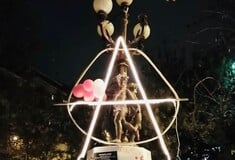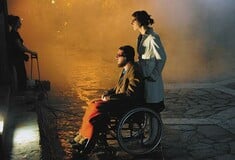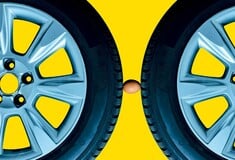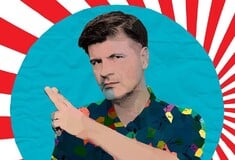Αναχρονιστική ζωή
Πόσο αναχρονιστική και παλιά η ζωή μας, πόσο απολιθωμένο το περιβάλλον της, σε σχέση με το σημερινό αδιανόητο επιστημονικό και τεχνικό δυναμικό της ανθρωπότητας
"Αφότου έγινε κατοικήσιμος ο Διεθνής Διαστημικός Σταθμός, οι ερευνητές άρχισαν αμέσως να το χρησιμοποιούν για να μελετήσουν τα αποτελέσματα της μικροβαρύτητας και άλλων διαστημικών επιπτώσεων που αφορούν πολλές πτυχές της καθημερινής μας ζωής. Αυτή η μοναδική στο είδος της επιστημονική πλατφόρμα συνεχίζει να επιτρέπει στους επιστήμονες ανά τον κόσμο να ασκούν τα ταλέντα τους μέσω καινοτόμων πειραμάτων που θα ήταν αδύνατο να πραγματοποιηθούν αλλού. Ο κοινός στόχος είναι να μοιραστούμε την κεκτημένη γνώση για τη βελτίωση της ζωής της ανθρωπότητας. Μπορεί να μην γνωρίζουμε ακόμη ποια θα είναι η πιο σημαντική ανακάλυψη που θα γίνει επί του διαστημικού σταθμού, αλλά έχουμε ήδη σημειώσει εξαιρετική πρόοδο! Πράγματι, τα οφέλη για την ανθρώπινη ζωή έχουν ήδη καταδειχθεί στους τομείς της ανθρώπινης υγείας, της τηλεϊατρικής, της εκπαίδευσης και της παρατήρησης της Γης από το διάστημα. Αναφέρουμε για παράδειγμα την έρευνα για την παραγωγή εμβολίων, τις δορυφορικές εικόνες που διευκολύνουν τη γεωργία και τις επιχειρήσεις διάσωσης, καθώς και εκπαιδευτικά προγράμματα που εμπνέουν τις μελλοντικές γενιές επιστημόνων, μηχανικών και εξερευνητών του διαστήματος."
[Καναδική Υπηρεσία Διαστήματος, Τα οφέλη του Διεθνούς Διαστημικού Σταθμού για την ανθρωπότητα]
"Εξετάζοντας στην ολοτητά του το παρελθόν που μας είναι γνωστό, διαπιστώνουμε ένα πράγμα : σε αντίθεση με τις καταστάσεις, τις θρησκευτικές πεποιθήσεις, τα γεγονότα που αναπαράγονται ή δίνουν τη ψευδαίσθηση του χάους, η επιστήμη, και μόνο αυτή, εξελίσσεται πάντα προς την ίδια κατεύθυνση, χωρίς πισογυρίσματα. Το ίδιο δόγμα παραμένει και εμπλουτίζεται. Το πλαίσιο μέσα στο οποίο τα φαινόμενα ταξινομούνται και επεξηγούνται διευρύνεται μέχρι να τα συμπεριλάβει όλα σε μια συνεκτική σύνθεση. Τα μέσα δράσης που απορρέουν απ' αυτήν τη θεώρηση γίνονται κάθε μέρα όλο και πιο ισχυρά, όλο και πιο αποτελεσματικά. Κατευθύνουν ήδη τη ζωή μας και καθορίζουν το μέλλον μας. Θα είχε επομένως η Ιστορία κάποιο νόημα ;
Το πιστεύω. Πιστεύω πως η ανθρωπότητα εξελίσσεται σύμφωνα με ένα σχέδιο, ένα πλάνο που ξετυλίγεται, κι ότι αυτή η κανονικότητα που κρύβεται πίσω από αναταράξεις, υποχωρήσεις και αποτυχίες, μας επιτρέπει να μαντέψουμε πως αποτελεί ένα πρακτικό μοντέλο για όλα αυτά που πρόκειται να γίνουν, ενώ την ίδια στιγμή οργανώνεται εν αγνοία μας, ακόμη κι εναντίον μας. Η επιτυχία της επιστήμης αποδεικνύει καθώς φαίνεται ότι υπερβαίνει τις αστάθμητες πιθανότητες : δεν θα ήταν άτοπο να υποθέσουμε πως συμπίπτει με την ουσία του ανθρώπου. Είναι η θελησή του, το μέλλον του, η μοίρα του. Ωστόσο, ο κυριότερος παράγοντας της επιστημονικής προόδου δεν είναι μόνο η δίψα για μάθηση. Παρ' ότι οι άνθρωποι ζουν και πεθαίνουν μέσα στη σύγχηση, ο άνθρωπος είναι μία δύναμη που πορεύεται : κάτι στη φύση του τον ωθεί στα άστρα. Αν το άτομο επιθυμεί ένα εικονικό αλλού, που το παράλογο της ανθρώπινης μοίρας του εμπνέει, και το οποίο του προσφέρει η θρησκεία, η μεταφυσική, η λογοτεχνία, η ποίηση, ή πολύ απλά κάθε νύχτα το όνειρο, το είδος μας έχει ένα σκοπό : θέλει να κατασκευάσει τα απαραίτητα εργαλεία για να να πάει πίσω από τον ορίζοντα, προς ένα πραγματικό αλλού, προς τη μακρινή γη, προς τη θάλασσα, προς το ακαθόριστο σύμπαν."
[Jacques Blamont, Le chiffre et le songe, Histoire politique de la découverte (Ο αριθμός και το όνειρο, Πολιτική ιστορία της ανακάλυψης), εκδ. Odile Jacob, Paris 1993. Ο Jacques Blamont είναι αστροφυσικός, μέλος της γαλλικής Ακαδημίας των Επιστημών. Υπήρξε ένας από τους κύριους εμπνευστές του διαστημικού προγράμματος της Γαλλίας.]
Ένα απόσπασμα από μια συζήτηση με τον Henri Lefebvre (αρχεία INA, 1970). "Η Ιστορία, αυτό που ονομάζουμε Ιστορία, είναι ένα νεκροταφείο. Και δεν είναι μόνο το νεκροταφείο αυτών που έγιναν, είναι και το νεκροταφείο αυτών που υπήρχε δυνατότητα να γίνουν και δεν έγιναν. Τόσα μεγαλεία, τόσες ομορφιές που χάθηκαν!"
Το καθημερινό και η καθημερινότητα
(άρθρο του Henri Lefebvre για την Encyclopaedia Universalis, μεταφρασμένο στα αγγλικά από την Christine Levich - Yale French Studies n* 73)
Before the series of revolutions which ushered in what is called the modern era, housing, modes of dress, eating and drinking-in short, livingpresented a prodigious diversity. Not subordinate to any one system, living varied according to region and country, levels and classes of the population, available natural resources, season, climate, profession, age, and sex. This diversity has never been well acknowledged or recognized as such; it has resisted a rational kind of interpretation which has only come about in our own time by interfering with and destroying that diversity. Today we see a worldwide tendency to uniformity. Rationality dominates, accompanied but not diversified by irrationality; signs, rational in their way, are attached to things in order to convey the prestige of their possessors and their place in the hierarchy.
FORMS, FUNCTIONS AND STRUCTURES
What has happened? There were, and there always have been forms, functions and structures. Things as well as institutions, "objects" as well as "subjects" offered up to the senses accessible and recognizable forms. People, whether individually or in groups, performed various functions, some of them physiological (eating, drinking, sleeping), others social (working, travelling). Structures, some of them natural and others constructed, allowed for the public or private performance of these functions, but with a radical-a root-difference: those forms, functions and structures were not known as such, not named. At once connected and distinct, they were part of an undifferentiated whole. Post-Cartesian analytic thought has often challenged these concrete "totalities": every analysis of objective or social reality has come up with some residue resisting analysis, and the sum of such realities as seemed irreducible by human thought became a matter for infinite analysis, a reserve of divine thought. Every complex "whole," from the smallest tool to the greatest works of art and learning, therefore possessed a symbolic value linking them to meaning at its most vast: to divinity and humanity, power and wisdom, good and evil, happiness and misery, the perennial and the ephemeral. These immense values were themselves mutable according to historical circumstance, to social classes, to rulers and mentors. Each object (an armchair just as much as a piece of clothing, a kitchen utensil as much as a house) was thus linked to some "style" and therefore, as a work, contained while masking the larger functions and structures which were integral parts of its form. What happened to change the situation? The functional element was itself disengaged, rationalized, then industrially produced, and finally imposed by constraint and persuasion: that is to say, by means of advertising and by powerful economic and political lobbies. The relationship of form to function to structure has not disappeared. On the contrary, it has become a declared relationship, produced as such, more and more visible and readable, announced and displayed in a transparency of the three terms. A modern object clearly states what it is, its role and its place. This does not prevent its overstating or reproducing the signs of its meaningfulness: signs of satisfaction, of happiness, of quality, of wealth. From the modem armchair or coffee grinder to the automobile, the formfunction-structure triumvirate is at once evident and legible. Within these parameters, there come to be constructed multiple systems or subsystems, each establishing in its own way a more or less coherent set of more or less durable objects. For example, in the domain of architecture, a variety of local, regional, and national architectural styles has given way to "architectural urbanism," a universalizing system of structures and functions in supposedly rational geometric forms. The same thing is true of industrially produced food: a system groups products around various functionally specific household appliances such as the refrigerator, freezer, electric oven, etc. And of course the totalizing system that has been constructed around the automobile seems ready to sacrifice all of society to its dominion. It so happens that these systems and subsystems tend to deteriorate or blow out. Are even the days of car travel numbered? Whatever the case may be, housing, fashion and food have tended and still tend to constitute autonomous subsystems, closed off from one another. Each of them appears to present as great a diversity as the old modes of living of the premodern era. This diversity is only apparent. It is only arranged. Once the dominant forces making it possible for these elements to combine with one another is understood, the artificial mechanism of their grouping is recognized and the fatuousness of their diversity becomes intolerable. The system breaks down. All such systems have in common a general law of functionalism. The everyday can therefore be defined as a set of functions which connect and join together systems that might appear to be distinct. Thus defined, the everyday is a product, the most general of products in an era where production engenders consumption, and where consumption is manipulated by producers: not by "workers," but by the managers and owners of the means of production (intellectual, instrumental, scientific). The everyday is therefore the most universal and the most unique condition, the most social and the most individuated, the most obvious and the best hidden. A condition stipulated for the legibility of forms, ordained by means of functions, inscribed within structures, the everyday constitutes the platform upon which the bureaucratic society of controlled consumerism is erected.
A COMMON DENOMINATOR
The everyday is therefore a concept. In order for it to have ever been engaged as a concept, the reality it designated had to have become dominant, and the old obsessions about shortages-"Give us this day our daily bread . . ."-had to disappear. Until recently, things, furniture and buildings were built one by one, and each existed in relation to accepted moral and social references, to symbols. From the twentieth century onward, all these references collapse, including the greatest and oldest figure of them all, that of the Father (eternal or temporal, divine or human). How can we grasp this extraordinary and still so poorly understood configuration of facts? The collapse of the referent in morality, history, nature, religion, cities, space; the collapse even of perspective in its classical spatial sense or the collapse of tonality in music. . . . Abundance-a rational, programmed abundance and planned obsolescence-replacing shortage in the first world; destructive colonization of the third world and finally of nature itself. . . .The prevalence of signs; omnipresent war and violence; revolutions which follow one after another only to be cut short or to turn back against themselves . . . . The everyday, established and consolidated, remains a sole surviving common sense referent and point of reference. "Intellectuals," on the other hand, seek their systems of reference elsewhere: in language and discourse, or sometimes in a political party. The proposition here is to decode the modem world, that bloody riddle, according to the everyday. The concept of everydayness does not therefore designate a system, but rather a denominator common to existing systems including judicial, contractual, pedagogical, fiscal, and police systems. Banality? Why should the study of the banal itself be banal? Are not the surreal, the extraordinary, the surprising, even the magical, also part of the real? Why wouldn't the concept of everydayness reveal the extraordinary in the ordinary?
REPETITION AND CHANGE
Thus formulated, the concept of the everyday illuminates the past. Everyday life has always existed, even if in ways vastly different from our own. The character of the everyday has always been repetitive and veiled by obsession and fear. In the study of the everyday we discover the great problem of repetition, one of the most difficult problems facing us. The everyday is situated at the intersection of two modes of repetition: the cyclical, which dominates in nature, and the linear, which dominates in processes known as "rational." The everyday implies on the one hand cycles, nights and days, seasons and harvests, activity and rest, hunger and satisfaction, desire and its fulfillment, life and death, and it implies on the other hand the repetitive gestures of work and consumption. In modern life, the repetitive gestures tend to mask and to crush the cycles. The everyday imposes its monotony. It is the invariable constant of the variations it envelops. The days follow one after another and resemble one another, and yet-here lies the contradiction at the heart of everydayness-everything changes. But the change is programmed: obsolescence is planned. Production anticipates reproduction; production produces change in such a way as to superimpose the impression of speed onto that of monotony. Some people cry out against the acceleration of time, others cry out against stagnation. They're both right.
GENERAL AND DIVERSIFIED PASSIVITY
Common denominator of activities, locus and milieu of human functions, the everyday can also be analysed as the uniform aspect of the major sectors of social life: work, family, private life, leisure. These sectors, though distinct as forms, are imposed upon in their practice by a structure allowing us to discover what they share: organized passivity. This means, in leisure activities, the passivity of the spectator faced with images and landscapes; in the workplace, it means passivity when faced with decisions in which the worker takes no part; in private life, it means the imposition of consumption, since the available choices are directed and the needs of the consumer created by advertising and market studies. This generalized passivity is moreover distributed unequally. It weighs more heavily on women, who are sentenced to everyday life, on the working class, on employees who are not technocrats, on youth-in short on the majority of people-yet never in the same way, at the same time, never all at once.
MODERNITY
The everyday is covered by a surface: that of modernity. News stories and the turbulent affectations of art, fashion and event veil without ever eradicating the everyday blahs. Images, the cinema and television divert the everyday by at times offering up to it its own spectacle, or sometimes the spectacle of the distinctly noneverydayi violence, death, catastrophe, the lives of kings and stars-those who we are led to believe defy everydayness. Modernity and everydayness constitute a deep structure that a critical analysis can work to uncover. Such a critical analysis of the everyday has itself been articulated in several conflicting ways. Some treat the everyday with impatiencei they want to "change life" and do it quicklyi they want it all and they want it now! Others believe that lived experience is neither important nor interesting, and that instead of trying to understand it, it should be minimized, bracketed, to make way for science, technology, economic growth, etc. To the former, we might reply that transforming the everyday requires certain conditions. A break with the everyday by means of festival-violent or peaceful-cannot endure. In order to change life, society, space, architecture, even the city must change. To the latter, we might reply that it is monstrous to reduce "lived experience," that a recognition of the inadequacy of pious humanism does not authorize the assimilation of people to insects. Given the colossal technical means at our disposal and the terrifying dangers which lie in wait for us, we would risk, in that case, abandoning humanism only to enter into "superhumanism."





























σχόλια